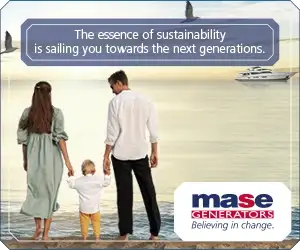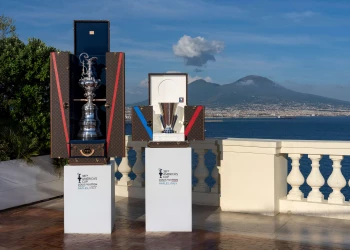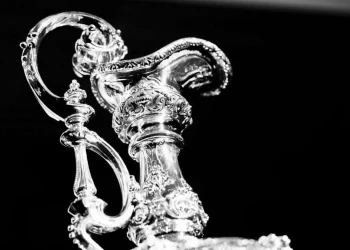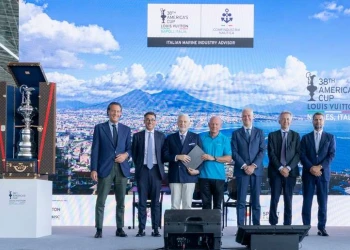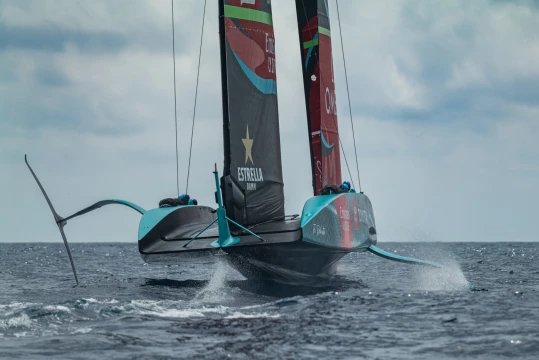
America's Cup, light air Barcelona flyers
America's Cup, light air Barcelona flyers
The recent cloudless Mediterranean skies were replaced by something more bruised today in Barcelona with a dense, high cloud cover that sat over the America’s Cup racecourse and indeed the city itself occasionally dropping rain but still no let up from the temperature in the high twenties with a lot of humidity. Port Vell was a busy place from early on with Emirates Team New Zealand leading the charge out followed by NYYC American Magic and INEOS Britannia all looking to get crucial light airs training under their belts.
Emirates Team New Zealand punched into a nasty little one-metre-high swell and were keen to get flying in the sub-5 knot conditions just after midday with a real concentration on power generation in a straight line. Curiously, the team didn’t opt for a J1 jib, preferring to pair the big M1 mainsail with the slightly smaller J2 jib and by and large they looked comfortable until losing the puffs on the return back into dock just before 3pm. It was a valuable three hours. Te Rehutai, their Cup winning AC75 looks at ease in the light belying its angular, muscular shape that looks so powerful in the heavier airs.
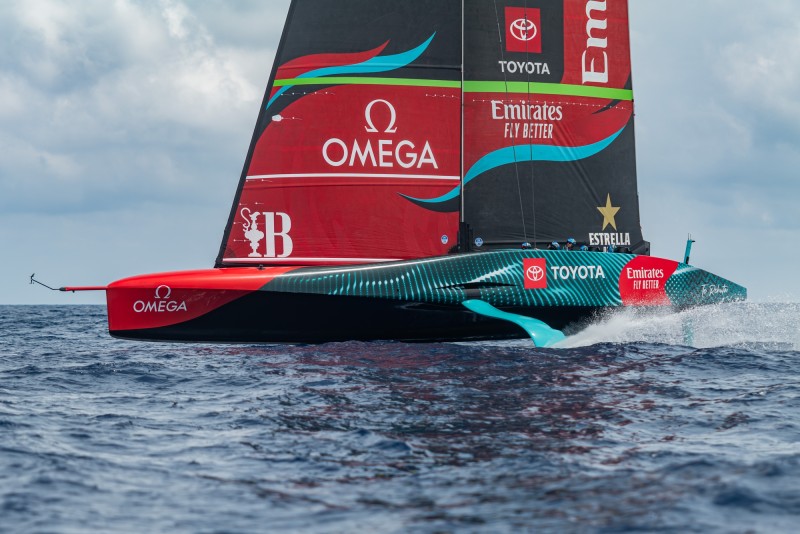
Pete Burling and Nathan Outteridge have utterly mastered such a smooth helming style whilst Blair Tuke and Andy Maloney seem very much to have the DNA of an AC75 coursing through their veins. Tacks were flat and low with plenty of ‘hold-your-breath’ moments as the two boards were down and the power came back on the new tack. Gybes were higher than usual but faster on the steering aligned with very clean windward board rises. On balance this was a day for giving every mode a shot, but the Kiwis keep coming back to the median of desperately low upwind, quite bow down whilst staying flat and pumping/flicking hard offwind – how they do it in such light conditions, and with a J2 up, is staggering.
Speaking afterwards Pete Burling very much gave the impression that the team are really learning in these light wind days saying: “Pretty interesting day today, a lot of cloud around so the temperature was a little bit colder, there was actually a bit of rain as well this morning, so it seemed like the breeze was just surging in and out. We had really nice breeze for a little bit when we first got out and then it completely shut away to nothing and then just filled in enough to get some nice sailing in. We focussed a little bit more on some straight-line sequences today and trying a few different techniques but all in all pretty productive day for us.”
Pete certainly gives the impression that he’s loving figuring out the conundrums that Barcelona often serves saying: “Definitely a tricky day where the swell is at a completely different angle to the breeze and it's right on the bottom end of things. Today was quite different to we've seen quite a lot of, with the swell actually to the right of the wind, we've had a lot of conditions obviously where the mistral is blowing the swell and it's coming quite a long way to the left. Yeah quite different day today, you can still definitely play your modes, you can sail fast if you need to, high yeah, obviously challenging for the trimming teams to keep the boat going fast and optimally trimmed but yeah that’s definitely part of the fun of the challenge of this venue.”
One of the key drills that Emirates Team New Zealand performs when the conditions allow is the ‘S’ course where they go from close hauled to fast bear-away, hold for a bit and then almost do an imaginary round-up and back onto an upwind course. We’ve seen Luna Rossa doing this in Cagliari where the presumption was to test foils. Same with INEOS Britannia in Barcelona but for the Kiwis, this looks very much like a numbers game and sailing to their angles. They did it today, even in the light, on port tack with Nathan steering. Interesting exercise whatever the weather. More to come this week from Emirates Team New Zealand.

New York Yacht Club American Magic elected to sail both of their AC40s out of the Port Vell and for the first 45 minutes of sailing it was tough as the boats ghosted in displacement mode. A quick tow further out to a breeze line saw Magic and America both get up on their foils and in the conditions, it was a day for straight-line testing with both boats featuring new underwater profiles in terms of foils and arms. Today Magic came out with a new long span anhedral port wing and the sailors were desperate to start the evaluation and data gathering.
In the conditions, speed differences were enhanced when either boat briefly touched down or got caught on a waveform. The swell was up, and it was hard sailing at times, but they persisted until just before 6pm and were rewarded with some reasonable breeze that touched 11 knots by the end.
Speaking afterwards, Finn Rowe, one of the hugely impressive youth sailors in the team gave a first-class interview and summed up the day saying: “It was a pretty good day, definitely was light, not much breeze at first when we poked our heads out of the harbour, so we had to do a little bit of sitting for around 30-45 minutes and then we kind of towed-out a little bit further from shore, the wind started to build a little bit from anywhere between 7 to 8 knots and then just kept building throughout the day. It got around 10-11 knots towards the end of the day, so it turned out to be a really nice day for two boat testing, we had a little bit of swell as well which is a nice added variable to the racing.”
The American Magic Youth sailors have seriously impressed so far with Finn, Severin Gramm and Harry Melges integrating so well with the team and getting plenty of on-water practise that will put them in a very good place come the racing next year. When asked whether they were spending a lot of time in the simulator, Finn commented: “Not yet. They're still getting the simulator up and running. They’re putting some stuff in there for us right now, I actually hopped on there yesterday just to do a little bit, they needed some people to hop in there just to do some testing for the guys that run the simulator but I think our AC40 simulator’s actually coming next week I believe, so as a youth sailor I'm really excited to hop in the 40 simulator and spend a lot of time in there before next fall for the Youth America’s Cup…that'll be awesome, we’ll have more youth sailors coming from the US to hop in there and it will really make us able to train more than we are right now.”
American Magic have got it all going on at the moment and are looking more impressive day by day. One to watch on all fronts in the America’s Cup in 2024 and at the pre-regattas.

INEOS Britannia brought both their prototype test boat ‘T6’ and their AC40 ‘Athena’ out of a very busy yard next to the MareMagnum Aquarium, docking out ‘T6’ at the same time as American Magic into a very windless stretch just outside the harbour. The British elected to attach the tow-line and get some foil data at pace along the coastline whilst the wind Gods decided their fate. Eventually there was enough to just get foiling right towards the end of the day and ‘T6’ was joined by the AC40 for some straight-line testing with Ben Ainslie swapping into ‘Athena’ to get maximum practice out of the session ahead of the first Preliminary Regatta in Vilanova i La Geltrú in less than a months’ time.
Unfortunately, Athena suffered an undisclosed breakdown that curtailed their session, thought to be an issue around the mast base that was not repairable on the water and T6 was left to sail on her own back to port in what was an eventful ride with plenty of nosedives and falls off the foils. The INEOS Britannia team were all back at the base just after 6.30pm – long day for the team.
Martin Fischer, Chief Designer for INEOS Britannia came to the recon interview after sailing and gave a wide-ranging interview. A busy man, this was his first time at the new base in Barcelona since it has been operational but he gave an insight into the operation back at Mercedes Applied Science in the UK, saying: “We have our main offices in in Brackley at the Mercedes Formula One site, we are working very closely together with them and Mercedes obviously is very big, but that's not all us, we have two offices in two different buildings and at the moment difficult to say I would say we are roughly between 40 and 50 people working on the design here.”
Talking about the raceboat ‘RB3’ and the milestones achieved so far, Martin wasn’t giving much away but did say: “I can't say at which stage we are, but for sure some of the milestones have passed others are coming up quickly so I guess I don't reveal any or disclose any secrets there if I say that at the moment there's a lot going on.”
And talking about the importance of T6 as a test and data platform for the team, Martin seemed pleased with what the team has achieved in terms of the build and the data platform it has delivered, saying: “It's very important, for us it's really a big element or big component of the whole campaign so we use it intensively to gather data to validate our models and then that feeds into the race boat design. It's extremely important…Yes I think I can say we're very happy, at least I'm happy, and I think so are most of the other people in our team as well I think. We think it was the right decision to go for a purpose-built boat. We learned so much putting this boat together that will be extremely useful for the raceboat, so I think it was extremely useful. It’s not a cheap exercise and it requires also lots of resources in terms of the manpower and working hours that's clear, but overall, I think it's worth the effort.”
INEOS Britannia are highly focussed on creating a fast AC75 capable of winning the America’s Cup and with some of the best sailors in this cycle, the team are starting to exude an air of confidence. The coming weeks and months will be fascinating.


